Starting Vegetables from Seed Indoors: A Comprehensive Guide
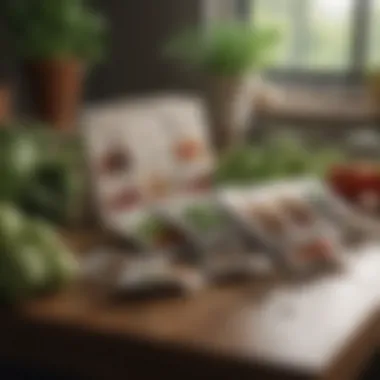
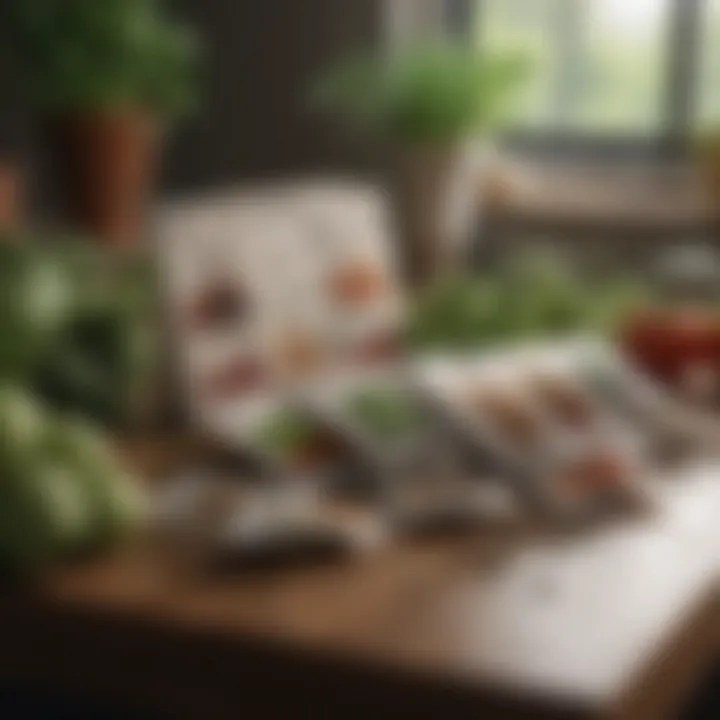
Intro
Starting vegetables from seed indoors offers numerous benefits that go beyond the mere satisfaction of growing your own food. With careful planning and the right tools, even those living in urban settings can indulge in the cultivation of various vegetable varieties. This article aims to provide a comprehensive understanding for individuals wishing to embark on this gardening journey. Whether you are a seasoned gardener or a newcomer, the insights provided will aid in establishing a successful indoor seed-starting routine.
Indoor gardening allows for an extended growing season, reducing the reliance on store-bought produce. As well, having control over growing conditions can lead to healthier plants. However, this endeavor is not without its challenges. Mismanagement of light, temperature, and moisture can hinder seed germination, resulting in disappointing outcomes. Here, we will examine each essential aspect for starting vegetables from seed indoors.
Design Inspiration
Trending Styles
While the focus is primarily on the practicality of growing vegetables, aesthetics can also play a role in indoor gardening. Utilizing various containers and planting setups can create a visually pleasing environment. Vertical gardening, through the use of shelves or hanging planters, has gained popularity. It maximizes space while providing an elegant look. Consider using terracotta pots, ceramic containers, or repurposed items to achieve a unique style.
There are also hydroponic systems available that not only serve their purpose but can also act as design features in modern homes. By choosing styles that align with your interior, you can integrate gardening into your home seamlessly.
Color Palettes
Choosing containers with distinct colors can enhance your indoor garden’s appeal. Earthy tones, such as browns and greens, can provide a calming atmosphere while vibrant colors like yellows and reds can energize the space. Aligning vegetable choices with the aesthetics can further enhance this integration. For example, colorful heirloom tomatoes or vibrant bell peppers can add splashes of color to a minimalist setup.
Practical Tips
Maintenance & Care
Ensuring the success of indoor seedlings requires regular maintenance and care. Here are essential tips:
- Watering: Keep the soil consistently moist but avoid overwatering. Using a spray bottle for gentle misting can ensure proper moisture without waterlogging the soil.
- Lighting: Natural light is optimal; however, grow lights can supplement when sunlight is scarce. Ideally, seedlings require 12-16 hours of light per day.
- Temperature: Most vegetable seeds germinate best at temperatures between 65°F to 75°F.
These factors can impact the health and vigor of your plants.
Budgeting & Planning
Starting vegetables from seed indoors can be both economical and rewarding. A clear budget and proper planning is essential to minimize unforeseen expenses. Here are steps to consider:
- Identify Vegetable Varieties: Not all seeds are created equal. Research and select varieties that thrive indoors and are suitable for your climate.
- Assess Equipment Needs: Depending on your approach, select basic essentials such as seed trays, potting soil, and a watering can, ensuring they fit your budget.
- Schedule Planting Times: Knowing when to start seeds based on estimated last frost dates is key. Create a timeline that aligns with your local growing season.
Proper planning lays the groundwork for success when germinating seeds indoors. By making informed choices and closely monitoring your seedlings, you can cultivate a flourishing indoor vegetable garden.
Preface to Indoor Seed Starting
Starting vegetables from seed indoors is a pivotal practice for avid gardeners. This method not only provides a head-start to the growing season but also maximizes the potential for a fruitful harvest. By starting seeds indoors, gardeners can control many factors that affect seed development, leading to stronger and healthier seedlings ready to be transplanted outdoors.
Importance of Starting Seeds Indoors
The significance of starting seeds indoors lies in its impact on the overall success of vegetable gardening. Many regions experience a short growing season, which limits the time available for plants to grow and yield. By initiating the germination process indoors, gardeners can extend their growing period, allowing crops like tomatoes or peppers, which require longer maturation times, to flourish.
Moreover, beginning seeds indoors protects them from unpredictable weather conditions. Seedlings are less susceptible to harsh winds, early frost, or pest invasions when safely housed indoors. This protection creates a controlled environment, offering consistent moisture, temperature, and light. All these factors contribute to a higher germination rate and more resilient plants as they transition outdoors.
Benefits of Indoor Seed Starting
Indoor seed starting provides several advantages that cater to both novice and experienced gardeners. A few key benefits include:
- Greater Variety Choices: When starting seeds indoors, you have access to many more vegetable varieties than what is typically available at local nurseries. This allows for an exciting selection tailored to personal tastes and local climate conditions.
- Cost-Effectiveness: Growing vegetables from seed can also save money. Buying seed packets is often cheaper than purchasing seedlings. Additionally, the potential for growing a larger quantity from seeds can lead to increased overall yield.
- Customized Growth Conditions: The indoor environment allows for specific customization, like using heating mats or grow lights. This tailored approach can encourage faster growth and development compared to outdoor sowing.
- Early Harvest: Starting seeds indoors typically results in earlier harvests, compensating for the short growing season in many areas. These earlier crops can deliver fresh produce ahead of those planted directly in the ground.
In summary, starting seeds indoors is a vital factor for gardeners who seek to maximize growth potential and maintain control over the early stages of plant development. With a proper understanding of the importance and benefits, anyone can take advantage of this productive approach.
Choosing the Right Vegetables
Choosing the right vegetables for indoor starting is a pivotal factor in the success of your gardening journey. Different vegetables have unique growing requirements, and selecting appropriate varieties can enhance your chances of cultivating healthy seedlings. By focusing on varieties that thrive in smaller spaces and specific indoor conditions, you ensure that your efforts yield fruitful results. Moreover, understanding the different growth times and care expectations for each type allows you to plan better for a successful growing season.
Best Vegetable Varieties for Indoor Starting
Tomatoes
Tomatoes are among the most popular vegetables to start indoors. Their variety is vast, enabling gardeners to choose from cherry, beefsteak, or heirloom, catering to different tastes. They do well in pots, making them suitable for indoor environments. One key characteristic of tomatoes is their need for warmth, which is easily managed indoors. However, tomatoes have a somewhat long growing season, which can be a challenge if space is limited. Still, their high yield and versatility in cooking make them a worthwhile choice.
Peppers
Peppers are another excellent option for indoor starting. They come in numerous varieties, such as bell, jalapeño, and habanero. These plants thrive in bright light and well-drained soil, both of which can be provided indoors. A noteworthy aspect of peppers is their longer growth time, similar to tomatoes; however, their fruits are often very rewarding. Peppers tend to be less demanding than some other vegetables. Therefore, their adaptation to indoor environments makes them a very worthwhile pursuit.


Leafy Greens
Leafy greens like spinach, kale, and lettuce are ideal for indoor gardens. They grow rapidly and can be harvested at multiple stages. One of their main benefits is that they require relatively less sunlight compared to fruiting vegetables. Additionally, leafy greens can thrive in smaller containers and are less sensitive to temperature fluctuations, making them a staple for indoor gardening. The main disadvantage is that their growth is highly dependent on consistent watering and nutrients. However, the quick results often offset this concern for many gardeners.
Herbs
Herbs such as basil, parsley, and cilantro are excellent for indoor cultivation. They offer fresh flavors and aromas that enhance various dishes. Herbs adapt well to container gardening, making them a popular choice. They typically have short growth cycles and require less space than other vegetables. A unique feature of herbs is their tolerance for indoor temperatures, which can be varied. However, some demand consistent light and moisture levels, which may require more attention than other indoor vegetables.
Considerations for Climate and Growth Time
When choosing vegetables to start indoors, it is crucial to consider the climate and growth time of the plants. Different varieties flourish under various conditions, and understanding these factors is essential for success. For instance, many plants require warmth and lots of light, which is particularly important during colder months. Assessing your indoor climate—temperature and humidity—can help you determine which vegetables will thrive.
Moreover, understanding the growth time of each vegetable allows you to plan your gardening activities. Some vegetables, like leafy greens, provide quick results, while others, like tomatoes, take longer to mature. Timely planning ensures that the plants are ready for transplanting outdoors at the right moment and can lead to a more bountiful harvest. By considering both climate and growth time, gardeners can make informed decisions about their indoor planting, leading to more successful gardening outcomes.
Essential Materials and Equipment
Starting vegetables from seed indoors requires careful consideration of certain essential materials and equipment. The right tools can make the difference between healthy seedlings and failed attempts. Each component works together to create an optimal environment that supports growth and minimizes challenges. Here’s a closer look at the crucial items you will need.
Seed Trays and Containers
Selecting suitable seed trays and containers is paramount for your indoor garden. These vessels hold the growing medium and support seed development. When choosing them, consider size, drainage, and material.
- Size: Trays with multiple cells are ideal for starting various seeds at once. Some larger containers work well for plants that need more space for root development, like tomatoes.
- Drainage: Ensure containers have drainage holes to prevent waterlogging. Excess water can lead to root rot and other problems.
- Material: Options include plastic, biodegradable pots, and metal. Plastic is reusable, while biodegradable pots can be planted directly in the ground, reducing transplant shock.
Growing Medium Options
The growing medium is another vital component for indoor seed starting. It provides the necessary nutrients, air, and water for seedlings to thrive. You can choose from several types:
- Seed Starting Mix: A light, fluffy mix, specifically designed for seed germination. It retains moisture well and promotes good drainage.
- Peat Moss and Perlite: Mixing these can create an excellent medium. Peat moss retains moisture, while perlite improves aeration.
- Coconut Coir: This eco-friendly alternative to peat moss can enhance moisture retention and aeration as well.
Choosing the right growing medium impacts your seedlings’ growth. Always check the ingredients and avoid heavy soils that may compact around the seeds.
Lighting Solutions for Seedlings
Light is one of the most critical elements in the seed starting process. Seedlings need adequate lighting to grow strong and healthy. Natural sunlight may not always be sufficient, especially during shorter winter days.
- Grow Lights: LED or fluorescent grow lights provide the spectrum of light required for effective photosynthesis. Position them 2-4 inches above the seedlings to prevent leggy growth.
- Light Duration: Seedlings require around 12-16 hours of light each day. Automatic timers can simplify this process, ensuring consistent light exposure.
Quality lighting is essential to prevent seedlings from stretching and becoming weak. Investing in appropriate lighting options can yield a more successful indoor garden.
Watering Systems and Tools
Proper watering is crucial for seedling development. Too little water can dry out seedlings, while too much can drown them. Tools that aid in watering are beneficial in keeping the moisture levels balanced.
- Watering Can: A can with a narrow spout allows for precise watering. It’s best to water the base of the seedlings rather than the leaves to prevent fungal diseases.
- Misting Bottles: Useful for gently misting seedlings or maintaining humidity in closed environments. This method can be especially beneficial for delicate sprouts.
- Humidity Domes: When starting seeds, covering trays with humidity domes can help retain moisture. Remove them gradually once seedlings emerge to acclimatize them to a drier environment.
Understanding the needs of seedlings and adjusting watering practices accordingly is vital for reducing waste and promoting robust growth.
"Consistency in care is key to successful seed germination and seedling growth."
Overall, equipping yourself with the proper materials and equipment ensures your efforts in starting seeds indoors will be fruitful. Each item plays a role in promoting healthy growth, enhancing your gardening experience.
Sowing Seeds: Techniques and Tips
Sowing seeds indoors involves methods that can greatly impact the success of growing vegetables. The techniques and tips discussed in this section address critical aspects related to planting depth, adequate watering, and maintaining a suitable environment. Each of these factors can affect the growth of seedlings and their eventual transition to outdoor conditions. Awareness of these details helps the gardener optimize seed starting for better yields.
Proper Seed Planting Depths
Understanding the correct seed planting depths is essential for successful germination. Different vegetable seeds require different depths due to variances in size and type. For example, small seeds like lettuce or basil should be sown on the surface of the growing medium. This is becasue they need light to germinate. Conversely, larger seeds like beans or peas require more depth, typically about one to two inches.
"Planting too deep can impede germination, while planting too shallow can cause seeds to dry out or fail to develop properly."
Here are some recommended planting depths based on seed type:
- Tomatoes: 1/4 inch
- Peppers: 1/4 inch
- Carrots: 1/4 inch to 1/2 inch
- Squash: 1 inch
Planting depth also influences root development, so adjusting based on the seed's maturity time is necessary for optimal results. Use seed packets as a thorough guide to ensure you are planting at the right requirements.
Optimal Watering Practices
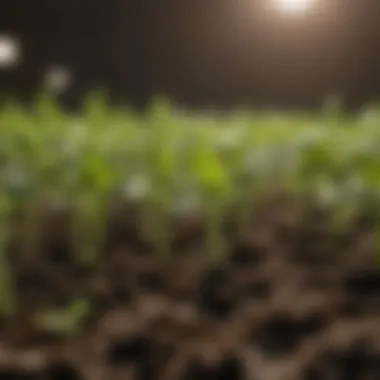
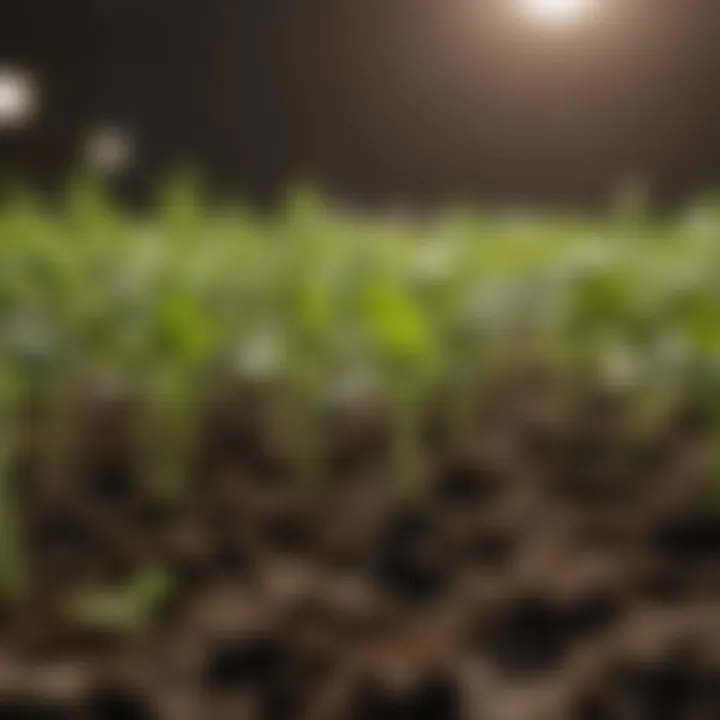
Watering practices play a vital role in seedling health. It is important to provide enough moisture without overwatering. Overwatering can lead to diseases such as damping-off, which can kill seedlings before they thrive.
Initial watering should use a gentle spray to avoid displacing seeds or damaging delicate seedlings. After germination, the watering frequency depends on the growing medium's dryness. Generally, keep the first inch of soil moist but not soggy.
- Best Practices:
- Water in the morning to avoid fungal issues.
- Use room temperature water to prevent stress on seedlings.
- Ensure good drainage in containers to manage excess water.
- Monitor soil moisture levels using your finger or a moisture meter.
Maintaining Temperature and Humidity
The environment in which seedlings grow affects their vigor. Temperature is crucial — most vegetable seeds germinate best between 70°F and 75°F. Any fluctuation below or above this range may delay germination or reduce growth rate.
Humidity also requires attention. Seedlings thrive in a humid environment, particularly in their early stages. A humidity dome or plastic cover can help retain moisture during germination. Open this covering gradually as seedlings grow to acclimatize them to normal indoor humidity levels.
- Tips for Maintaining Environment:
- Place seedlings in a warm, well-lit room.
- Regularly check and adjust temperature with thermometers.
- Use a hygrometer to monitor humidity.
Adequate temperature and humidity levels ensure seedlings have the best chance of becoming strong and healthy plants for later transplanting.
By mastering these techniques, gardeners can improve their success rates in starting vegetable seeds indoors. Understanding how to plant, water, and maintain seedling conditions effectively will lead to robust plants ready to thrive outdoors.
Caring for Indoor Seedlings
Caring for indoor seedlings is a crucial aspect of the seed starting process that demands attention and knowledge. From germination to the point where the plants are ready for transplanting, every phase requires specific care and consideration. This includes monitoring their growth, adjusting environmental conditions, and ensuring they receive the right nutrients. This section delves into these elements to highlight their significance in fostering robust seedlings.
Monitoring Growth and Adjusting Conditions
Observing the development of seedlings is vital. Each plant will undergo growth spurts at different rates. Some may remain relatively small, while others stretch towards the light source. Regular checks help in identifying these growth patterns. If seedlings exhibit signs of stunted growth, it could be a sign they need more light, nutrients, or perhaps a change in temperature.
To enhance growth, manage environmental factors.
- Lighting: Seedlings often need between 12 to 16 hours of light daily. Using fluorescent lights positioned just above the plants can help them grow strong and healthy.
- Temperature: Keep seedlings in a temperature range between 65 to 75 degrees Fahrenheit. Drastic temperature changes can shock plants, hindering their development.
- Humidity: A relative humidity level of 40 to 60% encourages healthy growth. Misting seedlings can help maintain humidity, especially in dry indoor environments.
Regularly adjusting these conditions fosters a more conducive growing environment. This often translates to faster and healthier seedling growth.
Fertilization Schedule for Seedlings
Nourishing young plants is critical for optimal growth. Seedlings benefit from a fertilization schedule that introduces essential nutrients without overwhelming them. Start using a diluted, balanced fertilizer about two weeks after the seeds germinate. This helps them transition from relying solely on seed reserves to absorbing nutrients for further growth.
When selecting a fertilizer, opt for one that contains equal parts nitrogen, phosphorus, and potassium. This balanced mix supports root development, flowering, and overall health of the seedlings.
A suggested fertilization routine can be as follows:
- Weeks 2-3: Fertilize every two weeks with diluted solution.
- Weeks 4-5: Transition to a weekly schedule if seedlings are thriving.
- Observation: Watch for yellowing leaves or stunted growth, which could indicate a nutrient deficiency and require immediate attention.
By maintaining a proper fertilization schedule, seedlings not only flourish but build the resilience needed for a successful transition to outdoor gardening.
Remember, every plant is different. Adjust care practices according to specific needs and behaviors observed during growth.
Transplanting Seedlings Outdoors
Transplanting seedlings outdoors is a critical step in the indoor gardening process. This stage marks the transition of young plants from their nurturing indoor environment to the more challenging outdoor conditions. It is essential to approach this process thoughtfully to ensure the survival and flourishing of seedlings. The importance of careful transplanting is highlighted by the fact that seedlings that are not properly acclimated or placed in unsuitable conditions may fail to thrive or even perish.
Key elements to consider in this process include timing, preparation of the outdoor site, and the techniques used during transplanting. Each aspect plays a significant role in enhancing the growth potential of the seedlings and minimizing shock during the transition. This guide aims to equip gardeners with the necessary tools and knowledge to make this pivotal phase successful.
Timing the Transplanting Process
The timing of transplanting is arguably as crucial as the act itself. It is essential to wait until the seedlings are strong enough to withstand outside conditions. Over the last few decades, the use of baselines like the last frost date has helped many gardeners determine the optimal time. Typically, this timing is influenced by local climate, plant variety, and the overall health of the seedlings.
Here are several guidelines for timing your transplant:
- Evaluate Seedling Strength: Seedlings should have multiple sets of true leaves and be sturdy before considering transplanting.
- Monitor Weather Conditions: Aim for a period of mild weather, avoiding extreme heat or cold. Nighttime temperatures should ideally remain above 50°F.
- Harden Off the Seedlings: Before transplanting, it is beneficial to acclimate seedlings to outdoor conditions gradually by exposing them to sunlight and wind for a week or two. This practice, also known as hardening off, will improve their chances of survival.
Preparing the Outdoor Garden Site
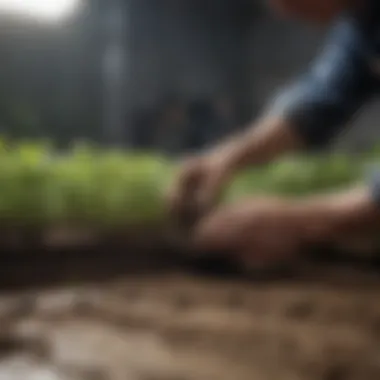
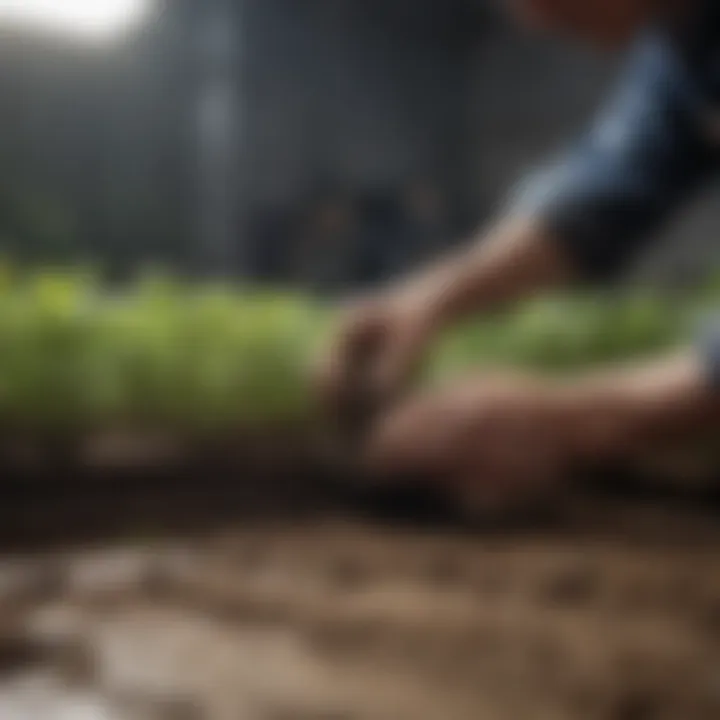
Preparing the outdoor garden site is an integral part of ensuring successful transplanting. A well-prepared site contributes to healthy root development and plant growth.
Follow these practical steps when preparing your gardening area:
- Select a Suitable Location: Look for an area that receives ample sunlight, as most vegetable plants require full sun for at least six hours a day.
- Soil Preparation: Prior to transplanting, amend the soil with organic material such as compost or well-rotted manure. This will improve soil structure, fertility, and drainage.
- Dig Holes Appropriately: The holes should be appropriately sized to accommodate the root ball of the seedlings without damaging them. Generally, the holes should be slightly larger than the root balls.
- Water the Holes: Before placing the seedlings, it is wise to water the holes to create a moist environment that reduces transplant shock.
Effective Transplanting Techniques
The method by which you transplant seedlings is essential for their successful establishment in the garden. Below are some effective techniques to consider:
- Gentle Removal: Carefully remove seedlings from their containers, holding them by the leaves instead of the stem to avoid damage.
- Positioning: Place the seedlings into the holes at the same depth they were growing in the pots. This helps to avoid stress on the roots.
- Backfill and Water: Gently backfill the soil around the roots. Ensure there are no air pockets, as they can hinder root growth. Water thoroughly after planting to settle the soil around the roots.
- Mulch: Adding a layer of mulch around the newly transplanted seedlings can help retain moisture and suppress weeds, which can compete for nutrients and water.
"Transplanting is not just about moving plants; it’s about ensuring their transition is smooth. Careful timing and preparation can make the difference between thriving and struggling plants."
Overall, transplanting seedlings outdoors is a nuanced process that requires attention to detail. By considering timing, site preparation, and techniques, gardeners can significantly increase the likelihood of successful growth for their vegetables. This process sets the stage for a fruitful gardening season.
Common Challenges and Solutions
Starting vegetables from seed indoors can provide a fruitful experience, but it is not free from its own set of challenges. Understanding the common problems faced during this process and their corresponding solutions is crucial to ensure success. By addressing these challenges, gardeners can enhance the health and vitality of their seedlings, which ultimately benefits their outdoor planting efforts and harvested yields.
Identifying Seedling Diseases
Seedlings are particularly vulnerable to diseases, which can manifest in various ways. Common illnesses include damping-off, a fungal condition that can kill young seedlings. Recognizing the signs of disease early can make a significant difference in treatment outcomes.
Here are some indicators to look for:
- Wilting: If seedlings appear droopy or wilted despite adequate watering, this may signal a problem.
- Discoloration: Yellowing leaves often indicate nutrient deficiencies or disease.
- Mold Growth: Presence of mold on the soil or seedlings themselves is a strong indication of damping-off.
To prevent these diseases:
- Use Sterilized Equipment: Make sure that seed trays, containers, and other tools are clean before use.
- Avoid Overwatering: Water only when necessary, which can help avoid fungal growth.
- Provide Adequate Airflow: Ensure proper ventilation around seedlings to reduce humidity that fosters disease.
"Maintaining a clean environment for your seedlings can significantly reduce disease risks."
Dealing with Pests Indoor and Outdoor
Both indoor and outdoor gardening can invite pests, which can quickly damage or destroy your seedlings. Common pests include aphids, spider mites, and fungus gnats. Proper identification is key to effective management.
Some effective strategies include:
- Regular Inspections: Check your seedlings often for signs of pest invasion. Detecting them early can prevent larger issues.
- Natural Remedies: Use neem oil or insecticidal soap sprays as environmentally friendly pest control options.
- Encourage Beneficial Insects: Ladybugs and lacewings can help keep aphid populations in check when introduced to your garden.
For outdoor pests, consider:
- Companion Planting: Certain plants, like marigolds, can repel harmful pests when planted alongside vegetables.
- Barriers: Floating row covers or fine mesh can protect seedlings from insects while still allowing sunlight and moisture in.
Understanding and addressing these challenges is essential for successfully growing vegetables from seed indoors. By taking preventive measures and swift action when necessary, any gardener can cultivate a thriving indoor garden.
Culmination and Future Considerations
The conclusion of our guide on starting vegetables from seed indoors serves as a vital recap and reflection on effective indoor gardening. Throughout the previous sections, readers have gained a thorough understanding of various essential elements like seed selection, growing conditions, and transplanting techniques. Recognizing the significance of these factors not only enhances the initial seedling phase but also contributes to the long-term success of indoor gardening practices.
Returning to the core lessons learned, it's clear that starting seedlings indoors allows gardeners to extend their growing season and increase crop yield. By carefully choosing suitable vegetable varieties, implementing optimal conditions, and addressing common challenges, individuals can foster a flourishing indoor garden environment. Furthermore, as new techniques and technologies emerge in horticulture, understanding these fundamentals equips gardeners to adapt and thrive.
Looking ahead, the sustaining interest in indoor gardening highlights its relevance in modern horticulture. Understanding the practices and principles covered in this article positions gardeners not just for immediate success but also for ongoing learning and experimentation.
"Gardening is a journey, not a destination. The more you learn, the more you grow."
Review of Key Points
- Importance of Indoor Seed Starting: Starting seeds indoors offers control over growing conditions, leading to healthier plants.
- Choosing the Right Vegetables: Understanding which vegetable varieties thrive indoors is essential. Focused selections can significantly affect outcomes.
- Essential Equipment: Proper materials such as seed trays, growing mediums, and quality lighting are necessary for successful seed starting.
- Sowing Seeds: Techniques like proper planting depths and optimal watering methods play critical roles in seedling development.
- Seedling Care: Consistent monitoring and adjustment of conditions can enhance growth and minimize problems.
- Transplanting Considerations: Successfully moving seedlings outdoors involves timing, site preparation, and effective implementation of transplanting techniques.
- Identifying Challenges: Awareness of potential diseases and pests allows for proactive management, ensuring healthy plants.
By synthesizing these key takeaways, readers can build a strong foundation and pursue productive gardening ventures with confidence.
Encouragement for Continued Learning
Gardening is an ever-evolving practice. With continuous research, innovations, and methods emerging, it's vital for enthusiasts to stay curious. Engaging in forums and communities such as those on reddit.com can offer insights and shared experiences among fellow gardeners. Participating in workshops or local gardening clubs provides further opportunities for growth and skill development.
Moreover, exploring diverse resources, like en.wikipedia.org and britannica.com, can broaden perspectives on horticultural science and techniques. Keep an open mind and embrace new ideas, as they can lead to unexpected successes.
Ultimately, ongoing learning not only enriches one's gardening knowledge but also nurtures a deeper connection to the earth and its offerings. As you embark on this journey, remember that every seed sown and every plant nurtured contributes to personal growth in more ways than one.















